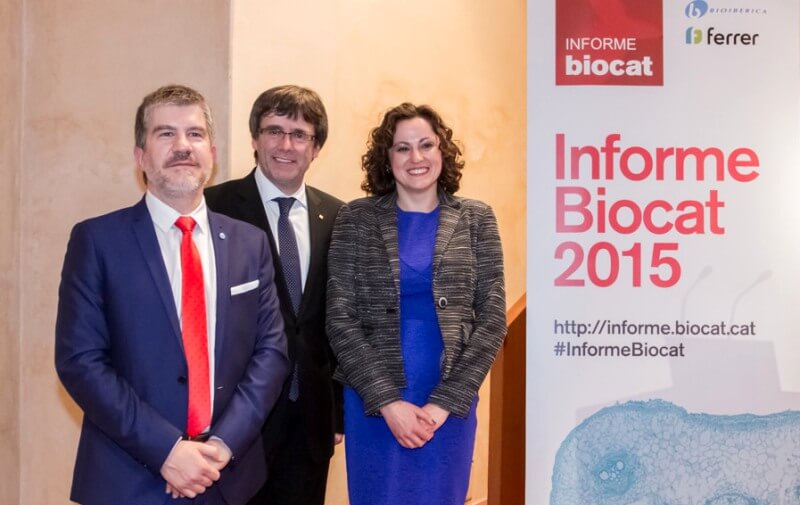
The turnonver of the 734 companies of the BioRegion amounts to 7% of Catalonia´s GDP
The life sciences and healthcare sector of Catalonia gathers 734 companies with a turnover of 14.360 million euros, 7% of Catalonia's GDP and employs 42,133 workers. These are some of the data yielded by the 2015 Biocat Report, presented last Thursday at the Palau de la Generalitat, which brought more than 200 politicians, business people and figures from academia and science. The event was presided over by the President of the Government of Catalonia, Carles Puigdemont, with the participation of Albert Barberà, CEO at Biocat, the organization that coordinates and promotes the health and life sciences sector in Catalonia, and Ella Korets-Smith, executive director of TO Health!, the Toronto´s life science cluster.
The report, compiled by Biocat –based at the Barcelona Science Park (PCB)– provides an overview of the evolution Catalonia´s BioRegion between 2013 and September 2015. The study evidences the positive consolidation of the life sciences and healthcare cluster in Catalonia, with the creation of 75 new businesses over this period, integrating a total of 734 companies and 89 research centres forming the ecosystem.
President Puigdemont confirmed that the data yielded by the report demonstrates “We should be proud, our commitment made all the sense in the world and still does. We still have a long way to go and we have to commit to research and innovation, but also to transfer. We have the conditions that make success possible. We will do everything in our power to make this one of the government’s top priorities,” said president Puigdemont in his speech. The Head of the Catalan Government also highlighted that Catalonia receives 53% of all grants that the European Research Council grants to the Spanish state and that Catalonia has technology and knowledge platforms such as the Supercomputing Center, Synchrotron or the Center for Genomic Analysis (CNAG), based at the Barcelona Science Park (PCB).
Albert Barberà, who presented the main data and conclusions of the report went on to say that “In terms of business growth and entrepreneurship, these 2 years, and in fact the past 10 years, have been positive on balance,” highlighted Barberà. “The increase in the number of companies, their size and the investment attracted and large business operations is proof of the progressive consolidation of our ecosystem”. In contrast, according to BioCat´s CEO, investment in public and private R+D in the sector has dropped nearly 11% between 2009 and 2014. Regarding scientific excellence, the report shows that, “Catalonia is still among the top regions in Europe in terms of quality and quantity,” stressed Barbera.
At the event, Ella Korets-Smith explained some of the key factors that have made the Canadian model successful and shared best practices that could be useful if applied to the ecosystem of the BioRegion of Catalonia. According to Korets-Smith, a successful cluster needs the right context, interesting activities and good resources and skills. “Activities aligned with needs, resources and business-friendly conditions are key to the success of cluster initiatives,” said Korets-Smith. The Canadian expert also highlighted the importance of all of the institutions involved being aligned in order to reach goals more quickly.
The Bioregion of Catalonia, in figures
The report, which reviews the situation of the sector in Catalonia between 2013 and September 2015 shows positive evolution of key indicators in the BioRegion of Catalonia, such as the 75 new companies created between 2013 and 2015. With this increase, the life sciences and healthcare sector in Catalonia gathers 734 companies: 221 biotechnology, 46 pharmaceutical, 94 innovative medical technology, 208 suppliers and engineering firms, 130 consulting and professional services and 26 active investment organizations. With these figures, despite being one of the smallest countries in Europe by population, Catalonia is among the top four European countries in terms of number of companies in the healthcare sector per inhabitant and the second in number of pharmaceutical companies per capita.
The BioRegion of Catalonia has 89 research bodies: 41 research centers, 15 university hospitals (of a total of 101 public and private hospitals), 11 universities with degrees in the life sciences, two large science facilities, seven technology centers and 13 science and technology parks with activity in the life sciences .
The number of publications contributed by these 89 centers in the healthcare and life sciences sector increased 168% between 2000 and 2015, which accounts for 3.15% of all scientific production in Europe, 0.99% in the world, and 29% of publications in Spain. Catalonia is ranked second in the EU in number of grants received from the European Research Council (ERC) per million inhabitant and it is awarded 53% of the grants from the ERC given Spain (180), 35% of which go to life sciences. (Source: Biocat)
See Biocat Report:
- Interactive online platform: http://informe.biocat.cat/en




